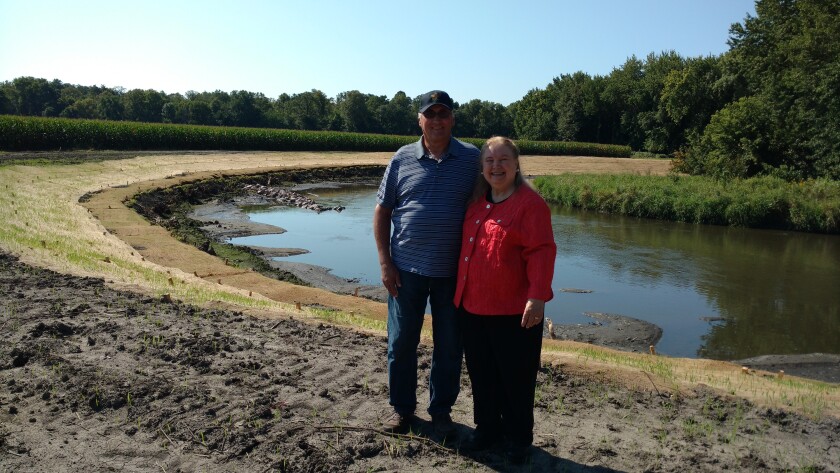WATSON, Minn. — Minnesota can count more than 12,000 lakes within its boundaries, but it is home to only a tad more than 200 calcareous fens.
They are one of the most rare and unique of landforms to be found in the state, and in good part because of it, many people have never heard of them.
ADVERTISEMENT
But, Megan Benage, a regional ecologist with the Minnesota Department of Natural Resources in New Ulm, knows them well, and what a natural treasure they represent.
She also knows one of the best.
“It’s BEAUTIFUL (all caps necessary),” wrote Benage of the calcareous fen near Watson in west central Minnesota's Chippewa County. She first visited it in August of 2018. “Incredible” and “stunning” were also among the adjectives she used in describing it. Indicator species of plants are spread throughout it. Many of them are rare and threatened plants. They are indicator species because they are plants that evolved to exist in the unique environment of a fen.
The Chippewa County board approved the sale of a 20-acre parcel holding the fen and native prairie to the Minnesota Department of Natural Resources at their meeting Nov. 17. Property owners Ruth Ann and Jerry Lee offered to sell the land to the DNR for its long-term protection after learning just how unique this and other fens are.

Ruth Ann witnessed Benage’s excitement when the regional ecologist first visited the fen. Calcareous fens have been in existence in western Minnesota for at least 3,000 years and in central Minnesota for more than 10,000 years, according to Benage.
ADVERTISEMENT
This one remains as it is thanks to the good stewardship of the Lees, she said. They grazed livestock on the site, and left intact the integrity of the fen as well as the native prairie.
“ is a mouthful to say, but really they are just peat-accumulating wetlands that depend on a constant supply of upwelling groundwater rich in calcium and other minerals,” Benage wrote to describe the fen. She said the calcium-rich environment supports highly diverse and unique plants that tolerate low oxygen conditions, calcium carbonate deposits, low nutrient availability and relatively cold organic soils, or peat.

Fens are dependent on groundwater ecology, and activities several miles distant can adversely affect the supply of water. They are the product of very localized conditions, and consequently most are small, according to Benage. Most calcareous fens in the state are no more than four acres in size.
Chippewa County holds nine of the state’s 200 or so fens, but their vulnerability to human activities, everything from tiling and open drainage to road building and groundwater usage, is apparent. The county has already lost one known fen, according to the ecologist.
Benage said she was both surprised and excited to discover that this fen near Watson has retained its original size.
ADVERTISEMENT
Ruth Ann Lee said her father and uncle originally purchased this land many years ago. It’s believed the dugout of an earlier settler was located here, but she and others have not been able to find it. Large boulders, deposited by the glaciers and known as “erratics” are part of the landscape.
Near the site stands a Montgomery Ward house, Lee said. The house was assembled by an early farm family prior to the arrival of electricity or modern plumbing.

She said her family has long recognized the high water table at the fen site. It’s been a place where you could stick a pipe into the hillside and water would flow, she said.
Walt Gessler, manager of the Lac qui Parle wildlife area, told the county commissioners that the site is being acquired to protect the fen and maintain the native prairie, provide additional recreational opportunities and additional access to state wildlife lands in that area. It adjoins existing wildlife land.
ADVERTISEMENT

Benage is likely to be only the very first of many, modern-day visitors to the fen who will be excited about what it offers. Gessler told the commissioners that the Lac qui Parle wildlife area attracts a lot of interests from naturalists. They use this outdoor area for training and the opportunity to explore native prairie and other unique features. There is no doubt the fen will be a prime example of what is protected here, he explained.
This fen is more than an example of one of the state’s most rare and unique landforms, according to Benage. It’s also an example of the importance of willing landowners who understand the value of these special places, and make it possible for the DNR to protect them. “And that’s what really makes Minnesota so special,” she added in an email.
What's a calcareous fen?
Calcareous fens are a unique type of wetland, according to the University of Minnesota-Duluth Natural Resources Research Institute. They have a substrate of non-acidic peat and require a steady supply of oxygen-poor groundwater that is rich in calcium and magnesium bicarbonate. They are among the rarest natural communities in the United States and support multiple rare plant species. They are especially vulnerable to surface and sub-surface disturbances that affect their groundwater regime.









